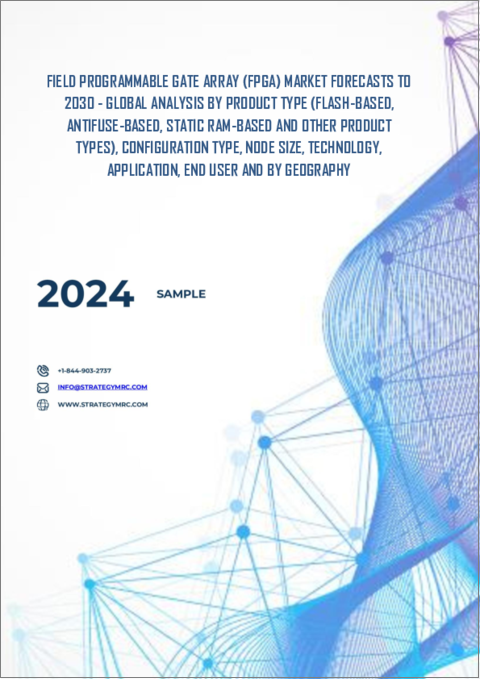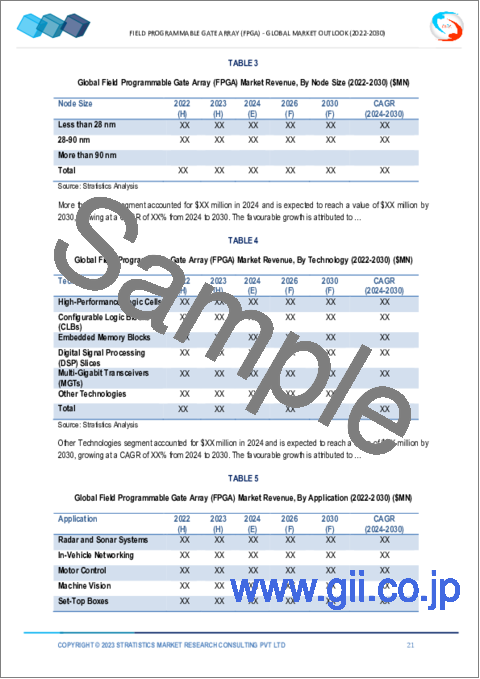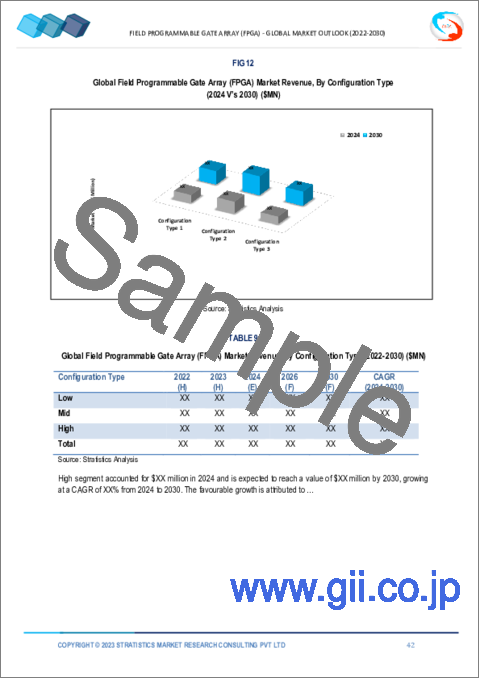|
|
市場調査レポート
商品コード
1530653
フィールドプログラマブルゲートアレイ(FPGA)の2030年までの市場予測: 製品タイプ、構成タイプ、ノードサイズ、技術、用途、エンドユーザー、地域別の世界分析Field Programmable Gate Array (FPGA) Market Forecasts to 2030 - Global Analysis By Product Type (Flash-Based, Antifuse-Based, Static RAM-Based and Other Product Types), Configuration Type, Node Size, Technology, Application, End User and By Geography |
||||||
カスタマイズ可能
|
|||||||
| フィールドプログラマブルゲートアレイ(FPGA)の2030年までの市場予測: 製品タイプ、構成タイプ、ノードサイズ、技術、用途、エンドユーザー、地域別の世界分析 |
|
出版日: 2024年08月01日
発行: Stratistics Market Research Consulting
ページ情報: 英文 200+ Pages
納期: 2~3営業日
|
- 全表示
- 概要
- 図表
- 目次
Stratistics MRCによると、フィールドプログラマブルゲートアレイ(FPGA)の世界市場は2024年に130億米ドルを占め、予測期間中のCAGRは11.5%で成長し、2030年には251億米ドルに達する見込みです。
フィールドプログラマブルゲートアレイ(FPGA)は、製造後に顧客や設計者が設定できるように設計された集積回路です。従来の固定機能チップとは異なり、プログラマブル相互接続を介して接続されたコンフィギュラブル・ロジック・ブロックのマトリックスを通じて柔軟性を提供します。これにより、ユーザーは特定のアプリケーションに合わせてハードウェアをカスタマイズすることができ、迅速なプロトタイピング、性能の最適化、適応性が可能になります。
NTTインドによると、これらのデータセンターでは、同様の容量の約70%がすでに予約済みだといいます。
新興テクノロジーの採用増加
市場における新興技術の採用が増加していることが、大きな進歩を促しています。これらの技術は、より高いパフォーマンス、柔軟性の向上、低消費電力を可能にし、AI、機械学習、IoTを含むさまざまなアプリケーションに理想的なものとなっています。高速インターフェース、ヘテロジニアス・コンピューティング、強化されたセキュリティ機能などの先進技術の統合は、それらを技術革新の最前線に押し上げ、最新のデジタル・システムやアプリケーションの高まる需要に応えています。
設計とプログラミングの複雑さ
設計とプログラミングの複雑さは、ハードウェア・レベルでのカスタマイズを可能にする柔軟性の高いアーキテクチャに起因します。この柔軟性は、ハードウェアとソフトウェアの両方の設計原理を深く理解することを必要とします。エンジニアは、複雑なタイミング制約、リソース割り当て、最適化の課題を解決しなければなりません。さらに、プログラミングにはHDLを使用することが多く、専門的な知識と経験が必要です。統合と検証のプロセスは、全体的な複雑さにさらに拍車をかけます。
データセンターとハイパフォーマンス・コンピューティング(HPC)の成長
データセンターとハイパフォーマンス・コンピューティングの成長が市場の需要を牽引しています。これらのプログラマブル・シリコン・チップは、複雑な計算や大規模なデータセットを効率的に処理するために必要な高性能と低レイテンシを提供します。データセンターがクラウドコンピューティングや機械学習アプリケーションをサポートするために拡大する中、ワークロードの高速化、パフォーマンスの最適化、エネルギー消費の削減のためのスケーラブルなソリューションを提供し、データ処理やHPC環境の進化に欠かせない存在となっています。
他の技術との競合
市場は、特定用途向け集積回路(ASIC)やグラフィックス・プロセッシング・ユニット(GPU)といった他の技術との競合に直面しています。ASICは、特定のタスクに対してより高い性能と低い消費電力を提供するため、大量生産アプリケーションに適しています。GPUは、人工知能や機械学習で好まれています。この競合は、柔軟性、再構成可能性、市場投入までの時間の短縮といった利点を提供し、多様なアプリケーションに対応し続けるために、絶えず進化し続けることを課題としています。
COVID-19の影響:
COVID-19の大流行は、世界のサプライチェーンを混乱させ、生産と納品に遅れを生じさせることで市場に大きな影響を与えました。操業停止や規制は製造活動の鈍化につながり、自動車や産業などの分野での需要は減少しました。しかし、パンデミック時にデータセンターや通信インフラへのニーズが高まったことで、これらの分野での採用が加速し、マイナスの影響を一部相殺しました。
予測期間中はモーター制御分野が最大になる見込み
予測期間中、モーター制御が最大となる見込み。柔軟性、リアルタイム処理、並列性を備え、精密なモーター制御アプリケーションに最適です。これには、電気自動車、産業オートメーション、ロボット工学、航空宇宙などが含まれます。モーター制御アルゴリズムのカスタマイズや複雑な制御戦略の実装が可能なため、パフォーマンスが向上し、待ち時間が短縮され、システム全体の信頼性が向上します。
予測期間中、産業オートメーション分野のCAGRが最も高くなる見込み
産業オートメーション分野では、運用効率と柔軟性を高めるために再構成可能なハードウェアが採用され、予測期間中のCAGRが最も高くなると予想されます。FPGAは、複雑なアルゴリズムとインタフェースをハードウェアに直接統合することで、製造プロセスにおけるリアルタイム処理と制御を可能にします。この技術は、プロセス制御、モニタリング、データ処理などのタスクを高い信頼性と適応性で最適化します。
最大のシェアを占める地域
北米は、通信、自動車、家電分野の進歩により、予測期間中最大の市場シェアを占めると予測されています。同地域は強力な研究開発投資の恩恵を受け、技術の進歩と市場の拡大を促進しています。高性能コンピューティングと人工知能アプリケーションの需要増加が市場成長をさらに後押しし、同地域は開発と展開の極めて重要な拠点として位置づけられています。
CAGRが最も高い地域:
予測期間中、アジア太平洋地域が最も高いCAGRを維持すると予測されます。主要企業は、多様な用途に合わせた革新的なソリューションで優位を占めています。スマートTVからゲーム機、ウェアラブル機器に至るまで、画像処理、信号処理、高性能と柔軟性を必要とするその他の機能に利用されています。また、レーダーシステム、航空電子工学、衛星通信、軍事用アプリケーションなど、各国が多額の投資を行っている分野にも不可欠です。
無料カスタマイズサービス:
本レポートをご購読のお客様には、以下の無料カスタマイズオプションのいずれかをご利用いただけます:
- 企業プロファイル
- 追加市場プレーヤーの包括的プロファイリング(3社まで)
- 主要企業のSWOT分析(3社まで)
- 地域セグメンテーション
- 顧客の関心に応じた主要国の市場推計・予測・CAGR(注:フィージビリティチェックによる)
- 競合ベンチマーキング
- 製品ポートフォリオ、地理的プレゼンス、戦略的提携に基づく主要企業のベンチマーキング
目次
第1章 エグゼクティブサマリー
第2章 序文
- 概要
- ステークホルダー
- 調査範囲
- 調査手法
- データマイニング
- データ分析
- データ検証
- 調査アプローチ
- 調査情報源
- 1次調査情報源
- 2次調査情報源
- 前提条件
第3章 市場動向分析
- 促進要因
- 抑制要因
- 機会
- 脅威
- 製品分析
- 技術分析
- 用途分析
- エンドユーザー分析
- 新興市場
- COVID-19の影響
第4章 ポーターのファイブフォース分析
- 供給企業の交渉力
- 買い手の交渉力
- 代替品の脅威
- 新規参入業者の脅威
- 競争企業間の敵対関係
第5章 世界のフィールドプログラマブルゲートアレイ(FPGA)市場:製品タイプ
- フラッシュベース
- アンチヒューズベース
- スタティックRAMベース
- その他の製品タイプ
第6章 世界フィールドプログラマブルゲートアレイ(FPGA)市場:構成タイプ別
- ローエンド
- ミッドレンジ
- ハイエンド
第7章 世界のフィールドプログラマブルゲートアレイ(FPGA)市場:ノードサイズ別
- 28nm未満
- 28-90 nm
- 90nm以上
第8章 世界のフィールドプログラマブルゲートアレイ(FPGA)市場:技術別
- 高性能ロジックセル
- 構成可能ロジックブロック(CLB)
- 組み込みメモリブロック
- デジタル信号処理(DSP)スライス
- マルチギガビットトランシーバー(MGT)
- その他の技術
第9章 世界フィールドプログラマブルゲートアレイ(FPGA)市場:用途別
- レーダーおよびソナーシステム
- 車載ネットワーク
- モーター制御
- マシンビジョン
- セットトップボックス
- ポータブル医療機器
- その他の用途
第10章 世界フィールドプログラマブルゲートアレイ(FPGA)市場:エンドユーザー別
- 通信
- 航空宇宙および防衛
- 自動車
- 産業オートメーション
- 家電
- ヘルスケア
- その他のエンドユーザー
第11章 世界のフィールドプログラマブルゲートアレイ(FPGA)市場:地域別
- 北米
- 米国
- カナダ
- メキシコ
- 欧州
- ドイツ
- 英国
- イタリア
- フランス
- スペイン
- その他欧州
- アジア太平洋
- 日本
- 中国
- インド
- オーストラリア
- ニュージーランド
- 韓国
- その他アジア太平洋地域
- 南米
- アルゼンチン
- ブラジル
- チリ
- その他南米
- 中東・アフリカ
- サウジアラビア
- アラブ首長国連邦
- カタール
- 南アフリカ
- その他中東とアフリカ
第12章 主な発展
- 契約、パートナーシップ、コラボレーション、合弁事業
- 買収と合併
- 新製品発売
- 事業拡大
- その他の主要戦略
第13章 企業プロファイリング
- Synopsys, Inc.
- Achronix Semiconductor Corporation
- SiliconBlue Technologies
- Actel Corporation
- Efinix Inc.
- Flex Logix Technologies, Inc.
- Silego Technology
- Teledyne
- Intel Corporation
- Microchip Technology Inc.
- Cypress Semiconductor Corporation
- NanoXplore Inc.
- Orange Tree Technologies
- InPA Systems
- Menta SAS
- Rambus Inc.
- Gowin Semiconductor Corporation
- Lattice Semiconductor
List of Tables
- Table 1 Global Field Programmable Gate Array (FPGA) Market Outlook, By Region (2022-2030) ($MN)
- Table 2 Global Field Programmable Gate Array (FPGA) Market Outlook, By Product Type (2022-2030) ($MN)
- Table 3 Global Field Programmable Gate Array (FPGA) Market Outlook, By Flash-Based (2022-2030) ($MN)
- Table 4 Global Field Programmable Gate Array (FPGA) Market Outlook, By Antifuse-Based (2022-2030) ($MN)
- Table 5 Global Field Programmable Gate Array (FPGA) Market Outlook, By Static RAM-Based (2022-2030) ($MN)
- Table 6 Global Field Programmable Gate Array (FPGA) Market Outlook, By Other Product Types (2022-2030) ($MN)
- Table 7 Global Field Programmable Gate Array (FPGA) Market Outlook, By Configuration Type (2022-2030) ($MN)
- Table 8 Global Field Programmable Gate Array (FPGA) Market Outlook, By Low-End (2022-2030) ($MN)
- Table 9 Global Field Programmable Gate Array (FPGA) Market Outlook, By Mid-Range (2022-2030) ($MN)
- Table 10 Global Field Programmable Gate Array (FPGA) Market Outlook, By High-End (2022-2030) ($MN)
- Table 11 Global Field Programmable Gate Array (FPGA) Market Outlook, By Node Size (2022-2030) ($MN)
- Table 12 Global Field Programmable Gate Array (FPGA) Market Outlook, By Less than 28 nm (2022-2030) ($MN)
- Table 13 Global Field Programmable Gate Array (FPGA) Market Outlook, By 28-90 nm (2022-2030) ($MN)
- Table 14 Global Field Programmable Gate Array (FPGA) Market Outlook, By More than 90 nm (2022-2030) ($MN)
- Table 15 Global Field Programmable Gate Array (FPGA) Market Outlook, By Technology (2022-2030) ($MN)
- Table 16 Global Field Programmable Gate Array (FPGA) Market Outlook, By High-Performance Logic Cells (2022-2030) ($MN)
- Table 17 Global Field Programmable Gate Array (FPGA) Market Outlook, By Configurable Logic Blocks (CLBs) (2022-2030) ($MN)
- Table 18 Global Field Programmable Gate Array (FPGA) Market Outlook, By Embedded Memory Blocks (2022-2030) ($MN)
- Table 19 Global Field Programmable Gate Array (FPGA) Market Outlook, By Digital Signal Processing (DSP) Slices (2022-2030) ($MN)
- Table 20 Global Field Programmable Gate Array (FPGA) Market Outlook, By Multi-Gigabit Transceivers (MGTs) (2022-2030) ($MN)
- Table 21 Global Field Programmable Gate Array (FPGA) Market Outlook, By Other Technologies (2022-2030) ($MN)
- Table 22 Global Field Programmable Gate Array (FPGA) Market Outlook, By Application (2022-2030) ($MN)
- Table 23 Global Field Programmable Gate Array (FPGA) Market Outlook, By Radar and Sonar Systems (2022-2030) ($MN)
- Table 24 Global Field Programmable Gate Array (FPGA) Market Outlook, By In-Vehicle Networking (2022-2030) ($MN)
- Table 25 Global Field Programmable Gate Array (FPGA) Market Outlook, By Motor Control (2022-2030) ($MN)
- Table 26 Global Field Programmable Gate Array (FPGA) Market Outlook, By Machine Vision (2022-2030) ($MN)
- Table 27 Global Field Programmable Gate Array (FPGA) Market Outlook, By Set-Top Boxes (2022-2030) ($MN)
- Table 28 Global Field Programmable Gate Array (FPGA) Market Outlook, By Portable Medical Devices (2022-2030) ($MN)
- Table 29 Global Field Programmable Gate Array (FPGA) Market Outlook, By Other Applications (2022-2030) ($MN)
- Table 30 Global Field Programmable Gate Array (FPGA) Market Outlook, By End User (2022-2030) ($MN)
- Table 31 Global Field Programmable Gate Array (FPGA) Market Outlook, By Telecommunications (2022-2030) ($MN)
- Table 32 Global Field Programmable Gate Array (FPGA) Market Outlook, By Aerospace and Defense (2022-2030) ($MN)
- Table 33 Global Field Programmable Gate Array (FPGA) Market Outlook, By Automotive (2022-2030) ($MN)
- Table 34 Global Field Programmable Gate Array (FPGA) Market Outlook, By Industrial Automation (2022-2030) ($MN)
- Table 35 Global Field Programmable Gate Array (FPGA) Market Outlook, By Consumer Electronics (2022-2030) ($MN)
- Table 36 Global Field Programmable Gate Array (FPGA) Market Outlook, By Healthcare (2022-2030) ($MN)
- Table 37 Global Field Programmable Gate Array (FPGA) Market Outlook, By Other End Users (2022-2030) ($MN)
Note: Tables for North America, Europe, APAC, South America, and Middle East & Africa Regions are also represented in the same manner as above.
According to Stratistics MRC, the Global Field Programmable Gate Array (FPGA) Market is accounted for $13.0 billion in 2024 and is expected to reach $25.1 billion by 2030 growing at a CAGR of 11.5% during the forecast period. A Field Programmable Gate Array (FPGA) is an integrated circuit designed to be configured by a customer or a designer after manufacturing. Unlike traditional fixed-function chips, they offer flexibility through a matrix of configurable logic blocks connected via programmable interconnects. This allows users to tailor the hardware for specific applications, enabling rapid prototyping, performance optimization, and adaptability.
According to NTT India, about 70% of the similar capacity in these data centers has already been reserved.
Market Dynamics:
Driver:
Increasing adoption of emerging technologies
The increasing adoption of emerging technologies in the market is driving significant advancements. These technologies enable higher performance, enhanced flexibility, and lower power consumption, making them ideal for various applications, including AI, machine learning and IoT. The integration of advanced technologies like high-speed interfaces, heterogeneous computing, and enhanced security features are propelling them to the forefront of innovation, catering to the growing demands of modern digital systems and applications.
Restraint:
Complexity of design and programming
The complexity of designing and programming stems from their highly flexible architecture, which allows for customization at the hardware level. This flexibility necessitates a deep understanding of both hardware and software design principles. Engineers must navigate intricate timing constraints, resource allocation, and optimization challenges. Additionally, programming often involves using HDLs, which require specialized knowledge and experience. The integration and verification processes further add to the overall complexity.
Opportunity:
Data center and high-performance computing (HPC) growth
The growth of data centers and high-performance computing is driving the demand for the market. These programmable silicon chips provide the high performance, and low latency needed to handle complex computations and large data sets efficiently. As data centers expand to support cloud computing and machine learning applications, they offer scalable solutions for accelerating workloads, optimizing performance, and reducing energy consumption, making them crucial in the evolving landscape of data processing and HPC environments.
Threat:
Competition from other technologies
The market faces competition from other technologies such as Application-Specific Integrated Circuits (ASICs) and Graphics Processing Units (GPUs). ASICs offer higher performance and lower power consumption for specific tasks, making them preferable for high-volume applications. GPUs are favored in artificial intelligence and machine learning. This competition challenges to continually evolve, offering advantages like flexibility, reconfigurability, and shorter time-to-market to remain relevant in diverse applications.
Covid-19 Impact:
The COVID-19 pandemic significantly impacted the market by disrupting global supply chains and causing delays in production and delivery. Lockdowns and restrictions led to a slowdown in manufacturing activities, while demand in sectors like automotive and industrial declined. However, the increased need for data centers and telecommunication infrastructure during the pandemic accelerated adoption in these areas, partially offsetting the negative effects.
The motor control segment is expected to be the largest during the forecast period
The motor control is expected to be the largest during the forecast period. They offer flexibility, real-time processing, and parallelism, making them ideal for precise motor control applications. These include electric vehicles, industrial automation, robotics, and aerospace. The ability to customize motor control algorithms and implement complex control strategies enhances performance, reduces latency, and improves overall system reliability, driving their adoption in the market.
The industrial automation segment is expected to have the highest CAGR during the forecast period
The industrial automation segment is expected to have the highest CAGR during the forecast period employing reconfigurable hardware to enhance operational efficiency and flexibility. FPGAs enable real-time processing and control in manufacturing processes, integrating complex algorithms and interfaces directly into hardware. This technology optimizes tasks like process control, monitoring, and data processing with high reliability and adaptability, crucial for modern industrial environments seeking agile and scalable automation solutions.
Region with largest share:
North America is projected to hold the largest market share during the forecast period driven by advancements in telecommunications, automotive, and consumer electronics sectors. The region benefits from strong R&D investments, fostering technological advancements and market expansion. Increased demand for high-performance computing and artificial intelligence applications further propels market growth, positioning the region as a pivotal hub for development and deployment.
Region with highest CAGR:
Asia Pacific is projected to hold the highest CAGR over the forecast period. Key players dominate with innovative solutions tailored for diverse applications. From smart TVs to gaming consoles and wearable devices, they are utilized for image processing, signal processing, and other functionalities that require high performance and flexibility. They are integral to radar systems, avionics, satellite communications, and military applications, sectors where countries are investing heavily.
Key players in the market
Some of the key players in Field Programmable Gate Array (FPGA) market include Synopsys, Inc., Achronix Semiconductor Corporation, SiliconBlue Technologies, Actel Corporation, Efinix Inc., Flex Logix Technologies, Inc., Silego Technology, Teledyne , Intel Corporation, Microchip Technology Inc., Cypress Semiconductor Corporation, NanoXplore Inc., Orange Tree Technologies, InPA Systems, Menta SAS, Rambus Inc., Gowin Semiconductor Corporation and Lattice Semiconductor.
Key Developments:
In April 2023, Lattice Semiconductor announced the launch of the Lattice MachXO5T-NX. This new system control FPGA has been developed to address the growing system management design complexity challenges faced by customers.
In October 2023, Microchip Technology Inc. introduced a set of nine new technology and application-specific solution stacks, which support their mid-range FPGA and System-on-Chip (SoC) offerings.
Product Types Covered:
- Flash-Based
- Antifuse-Based
- Static RAM-Based
- Antifuse-Based
- Other Product Types
Configuration Types Covered:
- Low-End
- Mid-Range
- High-End
Node Sizes Covered:
- Less than 28 nm
- 28-90 nm
- More than 90 nm
Technologies Covered:
- High-Performance Logic Cells
- Configurable Logic Blocks (CLBs)
- Embedded Memory Blocks
- Digital Signal Processing (DSP) Slices
- Multi-Gigabit Transceivers (MGTs)
- Other Technologies
Applications Covered:
- Radar and Sonar Systems
- In-Vehicle Networking
- Motor Control
- Machine Vision
- Set-Top Boxes
- Portable Medical Devices
- Other Applications
End Users Covered:
- Telecommunications
- Aerospace and Defense
- Automotive
- Industrial Automation
- Consumer Electronics
- Healthcare
- Other End Users
Regions Covered:
- North America
- US
- Canada
- Mexico
- Europe
- Germany
- UK
- Italy
- France
- Spain
- Rest of Europe
- Asia Pacific
- Japan
- China
- India
- Australia
- New Zealand
- South Korea
- Rest of Asia Pacific
- South America
- Argentina
- Brazil
- Chile
- Rest of South America
- Middle East & Africa
- Saudi Arabia
- UAE
- Qatar
- South Africa
- Rest of Middle East & Africa
What our report offers:
- Market share assessments for the regional and country-level segments
- Strategic recommendations for the new entrants
- Covers Market data for the years 2022, 2023, 2024, 2026, and 2030
- Market Trends (Drivers, Constraints, Opportunities, Threats, Challenges, Investment Opportunities, and recommendations)
- Strategic recommendations in key business segments based on the market estimations
- Competitive landscaping mapping the key common trends
- Company profiling with detailed strategies, financials, and recent developments
- Supply chain trends mapping the latest technological advancements
Free Customization Offerings:
All the customers of this report will be entitled to receive one of the following free customization options:
- Company Profiling
- Comprehensive profiling of additional market players (up to 3)
- SWOT Analysis of key players (up to 3)
- Regional Segmentation
- Market estimations, Forecasts and CAGR of any prominent country as per the client's interest (Note: Depends on feasibility check)
- Competitive Benchmarking
- Benchmarking of key players based on product portfolio, geographical presence, and strategic alliances
Table of Contents
1 Executive Summary
2 Preface
- 2.1 Abstract
- 2.2 Stake Holders
- 2.3 Research Scope
- 2.4 Research Methodology
- 2.4.1 Data Mining
- 2.4.2 Data Analysis
- 2.4.3 Data Validation
- 2.4.4 Research Approach
- 2.5 Research Sources
- 2.5.1 Primary Research Sources
- 2.5.2 Secondary Research Sources
- 2.5.3 Assumptions
3 Market Trend Analysis
- 3.1 Introduction
- 3.2 Drivers
- 3.3 Restraints
- 3.4 Opportunities
- 3.5 Threats
- 3.6 Product Analysis
- 3.7 Technology Analysis
- 3.8 Application Analysis
- 3.9 End User Analysis
- 3.10 Emerging Markets
- 3.11 Impact of Covid-19
4 Porters Five Force Analysis
- 4.1 Bargaining power of suppliers
- 4.2 Bargaining power of buyers
- 4.3 Threat of substitutes
- 4.4 Threat of new entrants
- 4.5 Competitive rivalry
5 Global Field Programmable Gate Array (FPGA) Market, By Product Type
- 5.1 Introduction
- 5.2 Flash-Based
- 5.3 Antifuse-Based
- 5.4 Static RAM-Based
- 5.5 Other Product Types
6 Global Field Programmable Gate Array (FPGA) Market, By Configuration Type
- 6.1 Introduction
- 6.2 Low-End
- 6.3 Mid-Range
- 6.4 High-End
7 Global Field Programmable Gate Array (FPGA) Market, By Node Size
- 7.1 Introduction
- 7.2 Less than 28 nm
- 7.3 28-90 nm
- 7.4 More than 90 nm
8 Global Field Programmable Gate Array (FPGA) Market, By Technology
- 8.1 Introduction
- 8.2 High-Performance Logic Cells
- 8.3 Configurable Logic Blocks (CLBs)
- 8.4 Embedded Memory Blocks
- 8.5 Digital Signal Processing (DSP) Slices
- 8.6 Multi-Gigabit Transceivers (MGTs)
- 8.7 Other Technologies
9 Global Field Programmable Gate Array (FPGA) Market, By Application
- 9.1 Introduction
- 9.2 Radar and Sonar Systems
- 9.3 In-Vehicle Networking
- 9.4 Motor Control
- 9.5 Machine Vision
- 9.6 Set-Top Boxes
- 9.7 Portable Medical Devices
- 9.8 Other Applications
10 Global Field Programmable Gate Array (FPGA) Market, By End User
- 10.1 Introduction
- 10.2 Telecommunications
- 10.3 Aerospace and Defense
- 10.4 Automotive
- 10.5 Industrial Automation
- 10.6 Consumer Electronics
- 10.7 Healthcare
- 10.8 Other End Users
11 Global Field Programmable Gate Array (FPGA) Market, By Geography
- 11.1 Introduction
- 11.2 North America
- 11.2.1 US
- 11.2.2 Canada
- 11.2.3 Mexico
- 11.3 Europe
- 11.3.1 Germany
- 11.3.2 UK
- 11.3.3 Italy
- 11.3.4 France
- 11.3.5 Spain
- 11.3.6 Rest of Europe
- 11.4 Asia Pacific
- 11.4.1 Japan
- 11.4.2 China
- 11.4.3 India
- 11.4.4 Australia
- 11.4.5 New Zealand
- 11.4.6 South Korea
- 11.4.7 Rest of Asia Pacific
- 11.5 South America
- 11.5.1 Argentina
- 11.5.2 Brazil
- 11.5.3 Chile
- 11.5.4 Rest of South America
- 11.6 Middle East & Africa
- 11.6.1 Saudi Arabia
- 11.6.2 UAE
- 11.6.3 Qatar
- 11.6.4 South Africa
- 11.6.5 Rest of Middle East & Africa
12 Key Developments
- 12.1 Agreements, Partnerships, Collaborations and Joint Ventures
- 12.2 Acquisitions & Mergers
- 12.3 New Product Launch
- 12.4 Expansions
- 12.5 Other Key Strategies
13 Company Profiling
- 13.1 Synopsys, Inc.
- 13.2 Achronix Semiconductor Corporation
- 13.3 SiliconBlue Technologies
- 13.4 Actel Corporation
- 13.5 Efinix Inc.
- 13.6 Flex Logix Technologies, Inc.
- 13.7 Silego Technology
- 13.8 Teledyne
- 13.9 Intel Corporation
- 13.10 Microchip Technology Inc.
- 13.11 Cypress Semiconductor Corporation
- 13.12 NanoXplore Inc.
- 13.13 Orange Tree Technologies
- 13.14 InPA Systems
- 13.15 Menta SAS
- 13.16 Rambus Inc.
- 13.17 Gowin Semiconductor Corporation
- 13.18 Lattice Semiconductor





